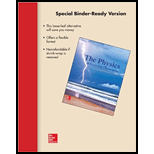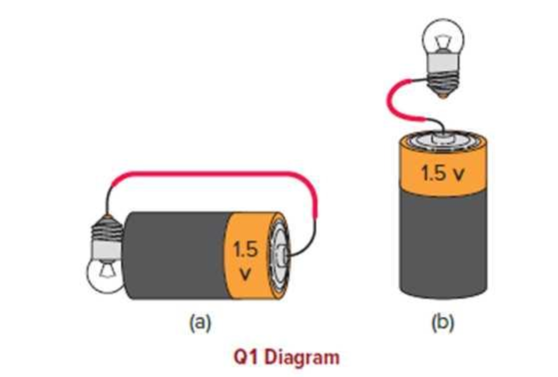
Two arrangements of a battery, bulb, and wire are shown. Which of the two arrangements, if either, will light the bulb? Explain.

Which of two arrangements will light the bulb.
Answer to Problem 1CQ
The bulb will light in arrangement
Explanation of Solution
To light the bulb, the circuit need to be closed. If the circuit is not closed, there will be no current and the bulb will not light.
In the arrangement
In the arrangement
Conclusion:
The bulb will light in arrangement
Want to see more full solutions like this?
Chapter 13 Solutions
Physics of Everyday Phenomena (Looseleaf)
- In cars, one battery terminal is connected to the metal body. How does this allow a single wire to supply current to electrical devices rather than two wires?arrow_forwardWe are often advised to not flick electric switches with wet hands, dry your hand first. We are also advised to never throw water on an electric fire. Why?arrow_forwardFind the currants flowing in the circuit in the preceding problem. Explicitly show how you follow the steps in the Problem-Solving Strategy: Series and Parallel Resistors.arrow_forward
- Why isn't a bird sitting on a high-voltage power line electrocuted? Contrast this with the situation in which a large bird hits two wires simultaneously with its wings.arrow_forwardYour car’s 30.0-W headlight and 2.40-kW starter are ordinarily connected in parallel in a 12.O-V system. What power would one headlight and the starter consume if connected in series to a 12.O-V battery? (Neglect any other resistance in the circuit and any change in resistance in the two devices.)arrow_forwardIn Figure P21.47, show how to add just enough ammeters to measure every different current. Show how to add just enough voltmeters to measure the potential difference across each resistor and across each battery.arrow_forward
- Consider the infinitely long chain of resistors shown below. What is the resistance between terminals a and b?arrow_forwardWhy will too many electrical electrical devices operating at one time often blow a fuse or trip a circuit breaker? Explain and justify your answerarrow_forwardIf you connected more light bulbs to both circuits, will the battery last longer if they were connected in (i) series or in (ii) parallel? Explain.arrow_forward
- When a pair of identical resistors are connected in series, which of the following is the same for both resistors—(a) voltage across each, (b) power dissipated in each, (c) current through each? Do any of your answers change if the resistors are different from each other?arrow_forwardAre car headlights connected in series or parallel? Give an everyday observation that supports your answer.arrow_forwardThe circuit shown has a battery and two resistors, with R1 > R2 . Which resistor dissipates the larger amount of power? Explain.arrow_forward
 Glencoe Physics: Principles and Problems, Student...PhysicsISBN:9780078807213Author:Paul W. ZitzewitzPublisher:Glencoe/McGraw-Hill
Glencoe Physics: Principles and Problems, Student...PhysicsISBN:9780078807213Author:Paul W. ZitzewitzPublisher:Glencoe/McGraw-Hill Principles of Physics: A Calculus-Based TextPhysicsISBN:9781133104261Author:Raymond A. Serway, John W. JewettPublisher:Cengage Learning
Principles of Physics: A Calculus-Based TextPhysicsISBN:9781133104261Author:Raymond A. Serway, John W. JewettPublisher:Cengage Learning College PhysicsPhysicsISBN:9781938168000Author:Paul Peter Urone, Roger HinrichsPublisher:OpenStax College
College PhysicsPhysicsISBN:9781938168000Author:Paul Peter Urone, Roger HinrichsPublisher:OpenStax College
 Physics for Scientists and Engineers with Modern ...PhysicsISBN:9781337553292Author:Raymond A. Serway, John W. JewettPublisher:Cengage Learning
Physics for Scientists and Engineers with Modern ...PhysicsISBN:9781337553292Author:Raymond A. Serway, John W. JewettPublisher:Cengage Learning Physics for Scientists and EngineersPhysicsISBN:9781337553278Author:Raymond A. Serway, John W. JewettPublisher:Cengage Learning
Physics for Scientists and EngineersPhysicsISBN:9781337553278Author:Raymond A. Serway, John W. JewettPublisher:Cengage Learning





